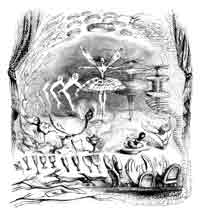Karim Al-Zand: Music: The Spinning Ballerina
The Spinning Ballerina
after an illustration by J. J. Grandville
The Spinning Ballerina is inspired by a fanciful illustration by J. J. Grandville (1803–1847), one of the most popular and innovative French illustrators of the 19th century. Grandville’s engravings and lithographs for editions of Gulliver’s Travels, Don Quixote, Robinson Crusoe and the fables of Fontaine and Aesop were highly regarded and much collected during his time. He is also well-known for his animal caricatures, often published in periodicals, in which anthropomorphized creatures enact humorous satires on contemporary politics and social mores. Un Autre Monde [Another World], published in 1844 with wood engravings by Grandville, is somewhat unusual in the history of illustration: the drawings were completed first and a text added only later, to string the images together. It is an eclectic work, reflected in Grandville’s own subtitle: “transformations, visions, incarnations, ascensions, locomotions, explorations, peregrinations, excursions, metamorphoses, cosmologies, phantasmagories…” The imagery from this later, more idiosyncratic period of his work stems from Grandville’s vivid and bizarre flights of imagination. The illustrations of Un Autre Monde reveal why Grandville has often been cited as a precursor to the surrealist movement of the early 20th century. As Robert Simon puts it, “the book charts an excursion to a parallel universe populated by mutant animals, vegetal/human hybrids, and inanimate objects come to life. The dreamscape they inhabit is equally fantastic.”
The ballerina illustration from Un Autre Monde probably best captures the whimsical  lunacy of Grandville’s drawings. Entitled “Apocalypse du Ballet,” the work also features several of the artist’s characteristic “metamorphoses”: here a ballerina emerges from a dancing foot, is transformed into a spindle and thread, eventually to take the form of a sprinting dog. Other metamorphoses can be seen in the foreground, as can the dancer’s love-struck admirer (the heart figure at left) and a newspaper critic (the feather plume holding a thurible). The remarkable image objectifies a sort of frantic, madcap motion. The work is a transcription of a movement from the orchestral work Visions from Another World.
lunacy of Grandville’s drawings. Entitled “Apocalypse du Ballet,” the work also features several of the artist’s characteristic “metamorphoses”: here a ballerina emerges from a dancing foot, is transformed into a spindle and thread, eventually to take the form of a sprinting dog. Other metamorphoses can be seen in the foreground, as can the dancer’s love-struck admirer (the heart figure at left) and a newspaper critic (the feather plume holding a thurible). The remarkable image objectifies a sort of frantic, madcap motion. The work is a transcription of a movement from the orchestral work Visions from Another World.
[A hi-res version of the image is available for download.]
DATE
2011
DURATION
6 minutes
INSTRUMENTATION
15 instruments: flute (/piccolo), oboe, clarinet, bassoon, horn, trumpet, trombone, 2 violins, viola, cello, double bass; percussion (2 players), piano, harp
The Spinning Ballerina also exists in a version for 16 players as part of a complete transcription of Visions from Another World
PREMIÈRE
February 23rd, 2011, Duncan Recital Hall, Shepherd School of Music, Houston TX
AUDIO
SCORE
PDF
